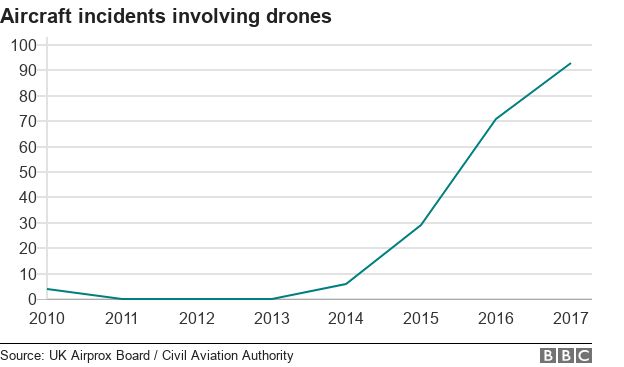New laws being introduced in the UK on 30 May 2018 will restrict all drones from flying above 400 feet and within 1 kilometre of airport boundaries.
Following a year-on-year increase in the report of drone incidents with aircraft – with 93 in 2017 – these measures will reduce the possibility of damage to windows and engines of planes and helicopters. The changes will come into effect on 30 July 2018.
The new laws will also require owners of drones weighing 250 grams or more to register with the Civil Aviation Authority (CAA) and for drone pilots to take an online safety test to ensure the UK’s skies are safe from irresponsible flyers. These requirements will come into force on 30 November 2019.
The changes are part of the future of mobility Grand Challenge, which was laid out in the government’s modern Industrial Strategy. Ensuring drones are being used safely will pave the way for the devices to play an increasingly important role in society.
Drones have the potential to bring great benefits to the UK, they already help inspect national infrastructure like our railways and power stations, and are even aiding disaster relief speeding up the delivery of blood. PwC has predicted the industry could be worth £42 billion in the UK by 2030.
The CAA and airports will have the power to make exceptions to these restrictions in specific circumstances.
Baroness Sugg, Aviation Minister, said:
We are seeing fast growth in the numbers of drones being used, both commercially and for fun.
Whilst we want this industry to innovate and grow, we need to protect planes, helicopters and their passengers from the increasing numbers of drones in our skies.
These new laws will help ensure drones are used safely and responsibly.
Chris Woodroofe, Chief Operating Officer, Gatwick Airport, said:
We welcome the clarity that today’s announcement provides as it leaves no doubt that anyone flying a drone must stay well away from aircraft, airports and airfields.
Drones open up some exciting possibilities but must be used responsibly. These clear regulations, combined with new surveillance technology, will help the police apprehend and prosecute anyone endangering the travelling public.
In addition to these measures a draft Drones Bill will be published this summer, which will give police more tailored powers to intervene on the spot if drones are being used inappropriately.
Drone operators will also eventually be required to use apps – so they can access the information needed to make sure any planned flight can be made safely and legally.
For model aircraft flying associations who have a long-standing safety culture, work is underway with the CAA to make sure drone regulations do not impact their activity.
The new laws are being made via an amendment to the Air Navigation Order 2016.
Drone users who flout the new height and airport boundary restrictions could be charged with recklessly or negligently acting in a manner likely to endanger an aircraft or any person in an aircraft. This could result in an unlimited fine, up to five years in prison, or both.
Users who fail to register or sit the competency tests could face fines of up to £1,000.
There has been a significant increase in the number of commercial permissions issued by the CAA in the last year. The number of active commercial licences increased from 2,500 to 3,800 in 2017, a year on year growth of 52%.
There has been a year on year increase in drone incidents with 71 in 2016 rising to 93 in 2017.
A recently released PwC report highlighted that the uptake of drones could be worth up to £41.7 billion to the UK GDP by 2030.
Drones are currently being used for a broad range of purposes across different industry sectors:
- Costain use drones for inspections at Hinkley Point C Nuclear Power Station, saving 50% of costs compared to the use of helicopters or human inspection teams
- the inspection of a wind turbine typically costs around $1,500 per tower. Performing the same inspection using a drone cuts the cost by around 50%
- Network Rail are using drones to improve track maintenance and boost field worker efficiency, whilst reducing the amount of work at height required on Network Rail’s assets
- the use of drone to deliver parcels significantly reduces costs, research by Deutsche Bank showed that drones cost less than $0.05 per mile to deliver a parcel the size of a shoe box, compared to delivery costs of up to $6.50 for premium ground services
- television shows such as Planet Earth II use drones to film wildlife hundreds of feet in the trees
How often are drones involved in aircraft incidents?
By BBC Reality Check
The number of aircraft incidents involving drones has grown dramatically in the past few years. In 2013 there were zero incidents, but that grew to almost 100 last year.
Civilian drones have grown increasingly popular as their price has fallen. Technological improvement has meant components are smaller, faster and cheaper than ever before.

The UK Airprox Board assesses incidents involving drones and keeps a log of all reports.
In one incident last year, for example, a pilot flying over Manchester saw a red “football-sized” drone passing down the left hand side of the aircraft.
In another incident, a plane leaving Glasgow narrowly missed a drone. The pilot, in that case, said the crew only had three seconds of warning and there was “no time to take avoiding action”.
Sources: Press Release; BBC
